Learning to use and get the most from Photoshop
Adobe Photoshop (Now part of their Creative Cloud suite of programmes) is 30 years old, now. First released on February 19th, 1990 after 2 years of development on Macs only, Photoshop has become a verb, like ‘Hoover’, for using a digital image editing programme to manipulate an image. But it can do a lot more than just touch up photos – It’s used by many artists for original art, including concept artists and User Interface professionals.
While originally you could buy Photoshop (At one point it was one of the most pirated software programmes in the world), since 2002 it has been part of the Adobe Creative Suite package of apps, and in June 2013 it became part of Creative Cloud instead, moving to a subscription model, whether you wanted to only use Photoshop, or bundle it with other apps. This both curtailed piracy, and meant that Adobe could make more money over time, as people couldn’t just buy one version of Photoshop and ignore upgrades until there was a feature they needed from a new version.
How does knowing Photoshop help me in eCommerce and DropShipping?
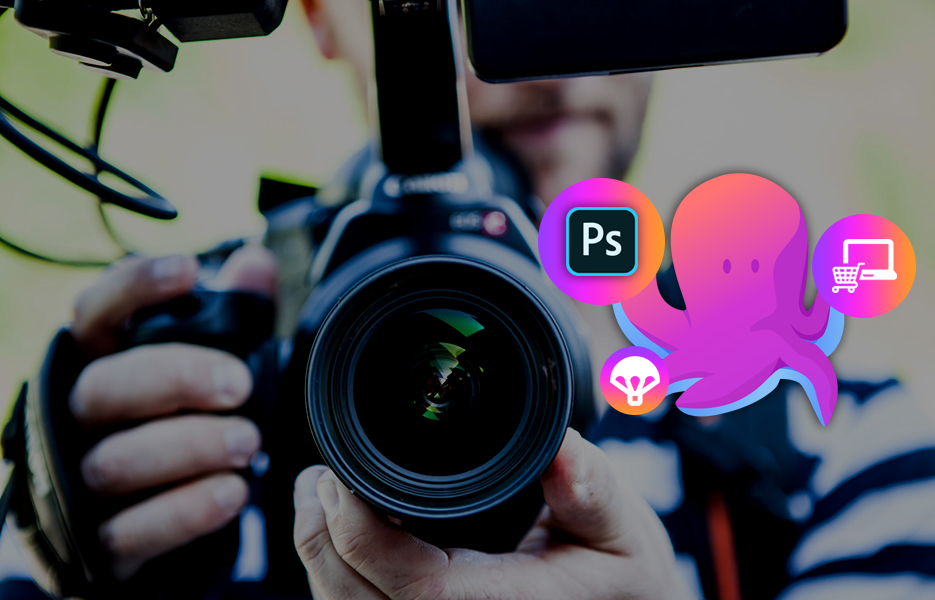
The web is a visual experience for many people. Good, clear pictures grab the attention and let people see what they are buying in the 7 seconds or so before they look at someone else’s offering.
Many marketplaces want pictures on plain white backgrounds, while social media posts can benefit from dynamic, bright and colourful images. The perfect image may be the wrong size or shape for a post on a specific social network (Instagram requires square images, for example), or the wrong size. Shrinking and cropping can make the image look worse if you don’t do so carefully.
Pinterest is a great tool for social reach, and requires good images. You might be thinking about going into T-Shirt design and Print on Demand.
In addition, if you want, you can use Photoshop to adjust colour content or balance in promotional images to be sympathetic to your company or brand’s colours.
Is Photoshop just one programme?
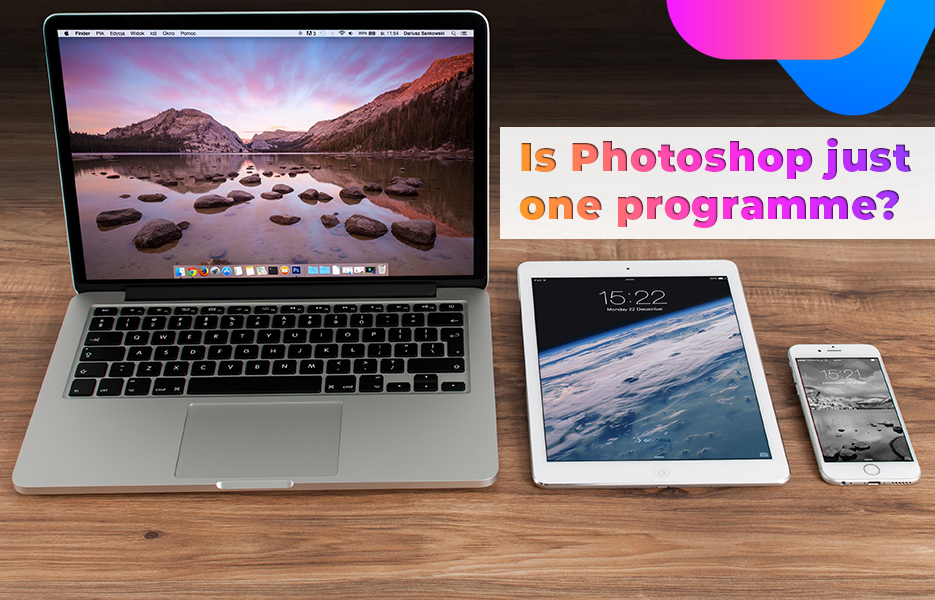
Photoshop (The main/primary programme) has been in continuous development since 1990, and went from Mac only to Mac and Windows. There’s also an online version of it usable through the web browser as part of the Creative Cloud, and a version for the iPad.
Lightroom
Photoshop Lightroom (or just ‘Lightroom’) is a specialized app or family of apps that started with just one product in 2007, and has progressed to versions being available on iOS and Android as well as Apple TV (tvOS). It’s specifically focused image organisation and optimization. It can’t doctor and manipulate specific elements like Photoshop, it’s focused on organizing, tagging and sharing them, with adjustments like colour balance to improve their appearance.
Lightroom’s focus is on non-destructive image editing, this means that any changes you make in Lightroom can be ‘rolled back’ should you change your mind, or decide to follow an alternative option. It also lets you apply those same changes to multiple images simultaneously, when you’re working in bulk.
Lightroom also lets you organize and easily work with large numbers of images, such as after a busy day at a photoshoot, or out and about doing nature photography. It can, as of version 4, also organize photos geographically (great after a holiday!), and can create slideshows, photobooks and web galleries.
Photoshop Elements
Originally introduced alongside Adobe Photoshop 6, it succeeded Adobe Photoshop LE (Limited Edition). Photoshop Elements is targeted at photography enthusiasts, and has a much more limited feature set than Photoshop, or Lightroom. It can’t export images in CMYK colour for professional printing, for example, and has photo retouching features like red eye reduction focused on users with less experience and training. As of the most recent version (Photoshop Elements 2020), Adobe stepped up and included features such as ‘one click subject selection’ to outline individual people in photos, content aware cropping (to avoid issues with selection of items ‘bleeding into other areas), and AI-powered facial expression editing powered by Adobe’s Sensei technology.
Photoshop Express
Photoshop Express is a free application for iOS and Android phones. There is also a version for Windows PCs available through the Microsoft Store. It offers a limited set of features for editing photos for non-expert users. We talk more about Photoshop Express here.
Photoshop Fix
Photoshop Fix is a mobile app for quick photo editing, retouching and restoration. Available for iOS or Android, it can also interact with Photoshop through the Creative Cloud platform, and pass images between the full app and the mobile app as needed.
Photoshop Sketch
Photoshop Sketch is a mobile sketching/drawing app for iOS and Android – Not everyone uses Photoshop for photo work, and Sketch is a lower cost solution to give access to those parts of Photoshop when they are on the move.
Photoshop Mix
Photoshop Mix is another of Adobe’s mobile apps. Available for iOS and Android, it’s designed to let you collage and adjust videos quickly and easily on a mobile device. We discuss Photoshop Mix in this blog article.
What are the main tools in Photoshop?
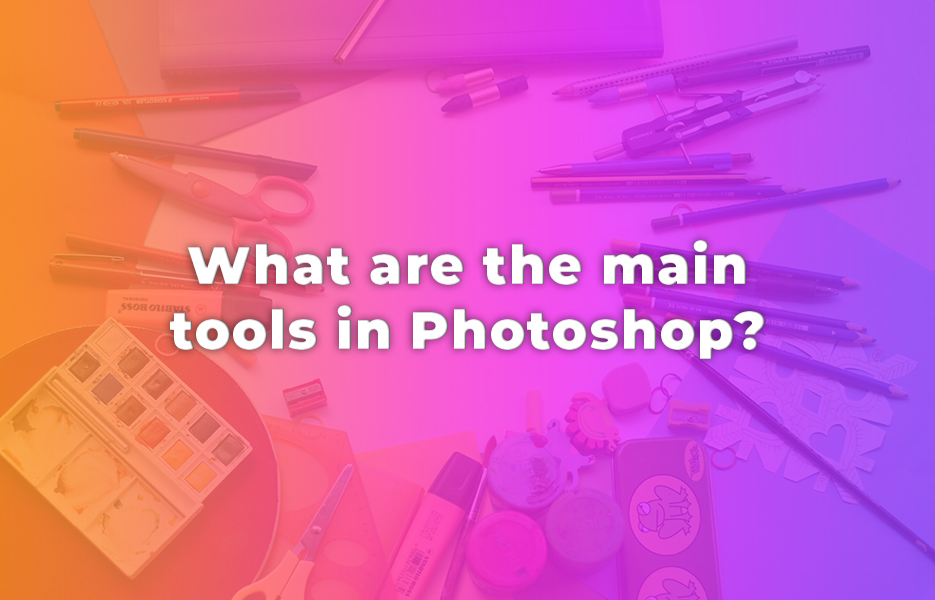
Photoshop has a wide range of tools available, and they can and have been used in a wide number of creative ways. We’ll look at tome of those tools before we proceed.
Layers
Images in Photoshop can be broken up into layers, stacked on top of each other. This means that you can build an image up without making irrevocable changes to it – Adding an object or caption? Put it in a layer on top of the image. If it needs to be edited or removed, the image below is simply uncovered again. Layers can also apply effects, like coloured overlays, and can be at varying levels of opacity – You could put a coloured block with a caption in it, and set that layer at 80% opacity, and the picture beneath would show through the caption slowly, for example.
0% Opacity is fully transparent, or invisible. Nothing on that layer will show up when you look at the image.
100% opacity is entirely solid, so any content on that layer will fully obstruct your view of anything on the layers ‘under’ it.
Layers can be moved ‘up’ and ‘down’ or hidden, allowing you to work on specific details without distraction, and you don’t have to work on the top layer – you can work on an active layer ‘under’ content’. Unless specified otherwise, a tool affects only a single layer (hence ‘active’ layer).
Pen
The Pen tool is a category of brush used to draw paths – these can be lines of varying depths and styles, or patterns (that may resemble media like airbrushes or paint). Some can be adjusted at anchor points which occur at changes in the direction of that path. Others, like the freeform pen tool, simply allow you to draw paths without any attempt to moderate or smooth out ‘jitters’ on the user’ part. The Magnetic Pen tool draws a line which follows the outline or edge of item(s) in the image, and can allow you to isolate items in an image.
Clone
The ‘Clone Stamp’ tool allows you to duplicate part of an image at another point. This is controllable, so you can choose a very small section, or a much larger area, such as a person or object, and treat it like a brush to apply one or more times. There are multiple modes for the tool, and you can clone on another layer to the one which the image originated on, and remove that layer if the clone doesn’t achieve the desired effect.
The clone tool is often used to heal or hide damage or blemishes in images without being too obviously ‘artificial’.
Shapes
Shapes can be drawn and manipulated in/on images within Photoshop – From primitive shapes like squares/rectangles, triangle and circles, to more complex elements like animals, plants or artificial shapes like traffic signs.
The shapes can be manipulated after they are inserted – Adjusting sizes in both dimension, rotating, rounding corners and other details.
Selection tools
When editing photos, the selection tools allow you to remove or adjust only certain areas of the image – the clone tool is an example of this. Selections can have filters applied to them, or be copied and pasted onto different layers, for example.
The Marquee tool can make selections of part of an image in an orderly way – Single column, single row, rectangular (select first corner by clicking, and 3rd corner by clicking again, 2nd and 4th are set automatically), elliptical (select 2 opposing corners of a bounding box where the ellipse touches the middle of each side), and then allows you to make adjustments to the content of that selection. The Lasso tool is a freeform selection, more akin to a pen with adjustable paths. It can be used to trace irregular objects.
What is the Magic Wand?
The magic wand tool automatically selects an area or areas of an image based on the values/colours of the pixels in the image in the selected layer. You can control the sensitivity of that selection (From only those areas with EXACTLY the same colour, to all the areas that are approximately purple, for example). You make your colour selection with the ‘eyedropper’ tool, and then can adjust the sensitivity based on the selection which is then created to moderate it.
What can I do once I have selected an area of an image?
The Crop tool can be used to remove all of the image EXCEPT the area selected, or the Cut tool removes it from the image, leaving the rest.
The Move tool allows you to relocate an element from one part of an image to another, leaving an area void, or empty that you will need to cover or replace.
Fills
When you make a selection in Photoshop, one of the options you have is to fill it with colour using the fill, or ‘paint can’ tool. The fill will obscure the layers beneath it, but the opacity of the active layer will decide if it obstructs your view of the layers below it, or merely tints the view that colour or colours. The colour or colours selected can then be applied the active layer in the selected layer as ‘solid’ or patterned fills (Such as checkerboard patterns).
This tool works in 2 modes:
Solid
In solid fill mode, the selected area or areas of the image, on the active layer, will be filled with the primary colour you selected.
Gradient
A gradient fill will start with your primary selected colour at one side of the selected area, the secondary selected colour at the opposite and, and creates a gradient balanced at the mid-point. You can then rotate the line that defines the angle the fill is at, and move the mid-point closer to one colour than the other if you choose. This customises the appearance of the fill.
The Eraser
With the Eraser tool, you can remove a section of the content in the selected layer of the current image. By removing it, you will be able to see ‘through’ that layer to content underneath.
Is Photoshop customisable?
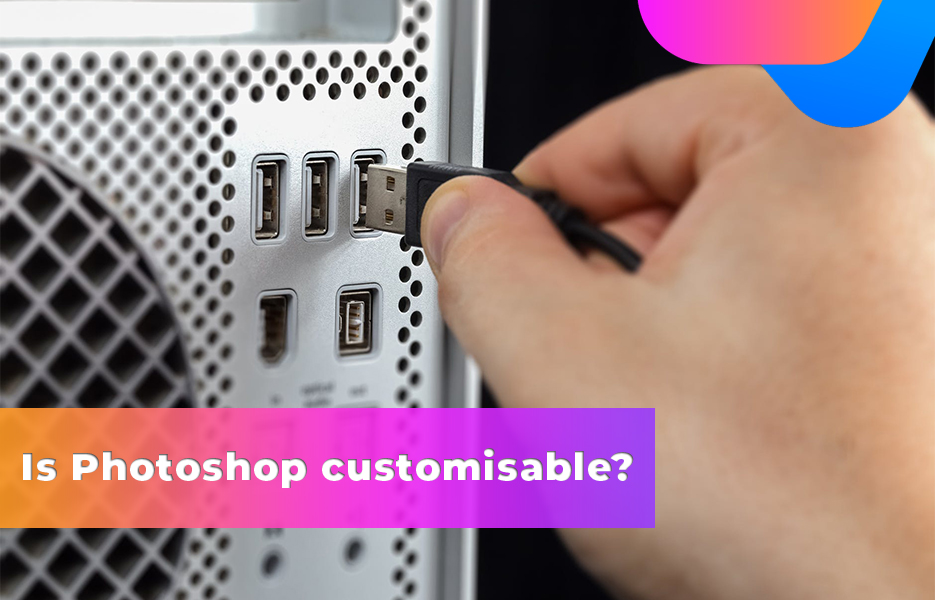
Photoshop has a lot of options for customizing how you work with images – They come under 2 broad formats, and can be found free or cheap depending on the provider and their perception of value. Some might be reproducible with work and experimentation, others are standalone mini apps on their own. They are grouped together as ‘Plugins’.
Some are provided by Adobe themselves (Adobe Camera Raw allows the manipulation and editing of RAW uncompressed digital image files from professional cameras such as SLRs without Lightroom). The majority are provided by third parties.
They can allow export into proprietary file formats, automation of processes or other options.
Brushes
Photoshop brushes allow you to apply colour, or images with other effects directly to an image file. They can encompass a wide range of final effects. One example is the Corel Particle Brush pack that brings Painter technology into Photoshop for some very impressive special effects, or realistic looking paint and other media.
Filters
Filters can apply colour correction effects or directly distort the contents of an image – for example Topaz Labs’ software, the ‘Alien Skin’ suite (now Exposure Software) or even 3D software like Strata
What is a PSD?
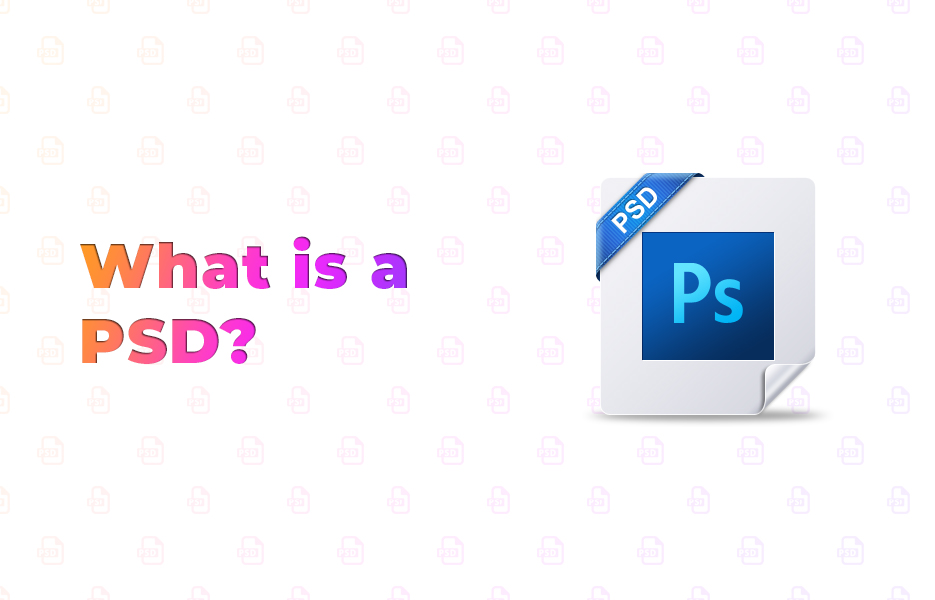
PSD (PhotoShop document) is the default file format that Photoshop saves image files in. It preserves the information about the image non-destructively, so that changes made can be undone or adjusted later.
The PSD file format supports many more features than the other formats Photoshop can export to, such as GIFs, JPEGs, PNGs and other file formats which may support some, but not all. These features include:
- Masks
- Transparency
- Editable text
- Alpha channels
- Spot colours
- Clipping paths
- Duotone settings
PSD Files are able to handle a maximum file size of 2 gigabytes (a DVD can hold 4.7 Gigabytes of data), or a maximum height AND width of 30,000 pixels.
PSB files (PhotoShop Big), or ‘large document format’ are a more recent development for extremely large documents, or those containing a lot of detail. A PSB file has a maximum size of 4 Exabytes (4,000,000 Gigabytes), and can have a maximum size of 300,000 pixels in height and width.
Both size limits are arbitrary decisions made by Adobe for ease of testing, rather than constraints imposed by data types or mathematics.
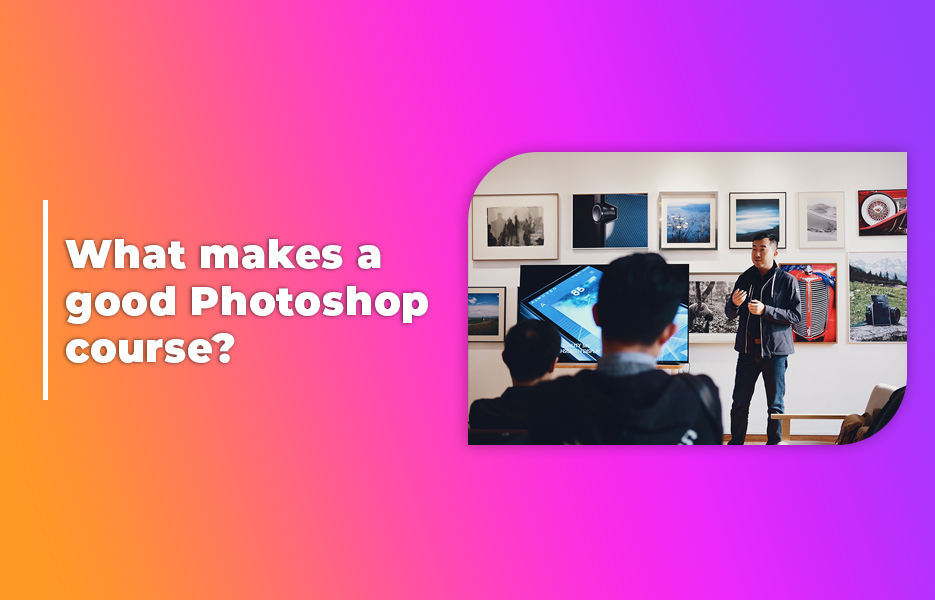
There are a large number of Photoshop courses available, and many of them are targeted at people of different levels of experience, and who use Photoshop for different purposes. Some have very broad focuses, some quite narrow. So we’ll look at a range of them, and state who they are targeted on.
Free articles and videos
Opening images in Photoshop CC (Beginner)
‘Photoshop Essentials’ is a website to help people get the most from Photoshop. It may seem simple, but Photoshop offers a number of ways to open image files for editing, and this article talks through the features of each and why you would use them, as well as difference in working with different file formats (Such as RAW, or uncompressed images).
Create new documents in Photoshop (Beginner)
If you’re creating an original image, you’ll be starting a brand new image. Photoshop offers lots of options (in addition to size and resolution). Photoshop Essentials will help you to learn what does what.
Adding contact and copyright information to images in Photoshop (Beginner)
When creating or sharing your images, it’s important to protect your work by adding details that will show that it’s yours, and let people get in touch with you if they want to find out more, or even to make a purchase! This article walks you through the File Information options available.
Sharpening images with a high pass mask (Moderate)
Once you have learnt the basics of Photoshop, you will realize there are fare more than just 1 or 2 ways to do most tasks, depending on the desired outcome. Normally you would use the ‘Smart Sharpen’ or ‘Unsharp Mask’ commands to sharpen up a blurry image. In this Photoshop Essentials article, we learn another method.
Cutting anything out in Photoshop (Moderate)
This video from ‘tutvid’ covers 10 tips and tricks for selecting and cutting out awkward and complex items in Photoshop images. It might just save you a Lot of time and frustration.
Colourising (changing the colours of) items in Photoshop (Moderate)
In this video, Aaron Nace at Phlearn talks about changing the colour of items (in this case hair) in an image, and making it look ‘natural’, so that it’s believable to the eye.
Adding someone into a photo (Moderate)
A common request is to insert someone into a photo after it has been taken (or an object, like one of your products). Digital Arts offer a tutorial here to help you make that happen. It walks you through the process with a sample image and project, and is rated to work for versions of Photoshop since Photoshop CS 5.
Selective/Spot Colours in Photoshop (Moderate)
Something seen a lot currently is the ‘spot colouring’ or ‘selective colouring’ method, where an image appears to be mostly black and white, with one or 2 items in a bright colour, such as red to stand out. In this video, spoon Graphics walk you through applying this to images, and some accompanying techniques to enhance the overall look of the finished image.
Using displacement maps in Photoshop to make inserted images wrap onto complex surfaces (Moderate)
When you buy or commission graphical elements, such as brand logos, then they will often come with something called a ‘displacement map’. In this video, Blue Lightning show you how to use displacement maps correctly, so you can apply you logo to clothing, for example, and use other effects to make them a seamless part of the image.
Blending test seamlessly into an image in Photoshop (Advanced
Sometimes you want to add in some text to an image to promote your brand. This video, by Justin Odishio, talks about blending text into an image with perspective, texture and warping so it appears to be part of the surface you apply it to.
VHS Glitch effects in Photoshop (Advanced)
A popular effect for images is the ‘VHS Glitch’ effect, which is based on the appearance of paused frames when there is a problem with a damaged or worn analogue video tape. It’s a mix of colours, distortion and other effects, and Tutsplus show you how to reproduce this effect in this tutorial.
Layer effects and styles in Photoshop CS 2020 (Advanced)
This is a free course made available for more advanced users by the website ‘Photoshop Essentials’.
Layer effects are non-destructive options to change the appearance of an image by changing the contents of a layer.
Layer styles are pre-set routines that also affect the appearance of an image through the settings for one or more layers on the image.
Paid courses
There are a wide range of Alternative solutions available at leading sites for Photoshop, whether general ‘Learn to use Photoshop’, or targeted ie. ‘Photoshop for Designers’, ‘Photoshop for Photographers’.
Some people prefer these courses because they have tutors, feedback and structure. Some people are happy to self-guide their learning based on the needs of their projects or job.
You can access courses from sites such as udemy and Lynda.com (Also known as LinkedIn Learning and available to LinkedIn Premium Subscribers). Remember to look at reviews before paying!
Alternative solutions
Photoshop has created whole area of how we use computers, and expect computers to work. Most people tend to ask for Photoshop skills if advertising for designers or people to work in digital imagery. But it’s far from the only great tool that you can use, and in some cases may not even be the best tool for the job!
Photo editing and digital design
Some programmes are designed to be used for a wide range of image manipulation and creation tasks – They start off as ‘just’ photo editors, but they grow, as Photoshop has grown. They can be found at a wide range of price points, starting free, and it’s always good to do some research to find the best tool for the job AND your budget!
GIMP (Free, Mac OSX, Windows, Linux)
GIMP (GNU Image Manipulation Programme) is a free, open source alternative to Photoshop. As an Open source programme, updates are a little slower, and the interface isn’t as slick – But it’s free, and bugs tend to be fixed quickly, as it has a thousand times as many people working on it as Photoshop.
GIMP might lack some of the more advanced tools, but it covers most of the same functionality, so it’s always worth giving it a try – It literally only costs you time. In addition, with a Linux version, sometimes it can be used on hardware that Photoshop isn’t suitable for when doing basic image editing – It’s much less memory intensive.
While Photoshop is no longer £700+ every year or two, it is still a commitment to a monthly subscription that adds up quickly (Even £10 per month is £120 per year). So free is still an attractive price point, especially for a powerful tool like GIMP.
GIMP supports many of the standard image editing and manipulation, including layers, filters and plugins (though there are more available for Photoshop). It loses out in some ways, though – Professional users might miss CMYK colour support, for example, and non-destructive photo editing, though these are in the planning stage.
Serif Affinity Photo (£48.99 Mac, £48.99 Windows, £18.99 iPad)
Affinity Photo was first developed and released by Serif (a long-term competitor of Adobe, based in the UK) in 2015, and is made available at a very reasonable price for a feature packed solution. Because you purchase it for a one-time payment, which may be more appealing than a Photoshop subscription. Its part of Serif’s Affinity suite of programmes, currently comprising Photo (released 2015, Designer (released 2014) and Publisher released 2018).
Affinity is a fully-featured photo editing app, just like Photoshop, supporting all the mainstream features, PSD and PSB files (seamlessly), importing PSD smart objects and edit the layers, RAW image editing, retouching, layers and filters. It also includes some other interesting tools and options, such as customizable workspaces, or ‘personas’ for specific tasks or projects.
Affinity Photo has a few interesting tricks of its own, too.
- Your undo history is saved in its native image format, so you can undo actions you took last week, last month, or last year even (Up to 8,000 steps).
- ‘Pano Stitching’ lets you create 360 degree panoramas by stitching images together, and helping you to align them and scale them to make it consistent. It goes without saying it can edit panoramic images from other sources, too.
- ‘Focus Merge’ can be used when merging layers – It helps you to setup focal distances, angles, etc., to give the final image an impressive depth of field effect when you look at the final image.
- Live brush previews when applying changes to images.
It also supports plug-ins, and there are an increasing number of options to help Affinity do whatever you need it to. It’s a strong contender, and becoming increasingly popular in professional and hobbyist circles. Installed, Affinity Photo is also less than half the size of Photoshop.
A lot of the things ‘missing’ in Affinity compared to Photoshop are rarely, if ever used by many people, and so aren’t a justifiable reason for staying with Adobe, but some people would rather stay with Photoshop to preserve their transferable skills. For beginners and more advanced users, Affinity has some very good help content, and there are an increasing number of courses, YouTube videos and other resources. There is also an Affinity Photo Workbook that can be purchased from their webstore for help and inspiration.
Corel Paintshop Pro (Paintshop Pro, £69.99, Paintshop Pro Ultimate £89.99, Windows)
Corel are a long-term competitor of Adobe’s, and are well known in the professional space for their ‘Corel DRAW!’ publishing and design software. Originally published as Paintshop, by JASC software in 1990, it was bought by Corel in 2004. There are 2 versions – Paintshop Pro, and Paintshop Pro Ultimate.
Paintshop Pro Ultimate is a bundled product, including other tools such as GRFX Studio (additional photo effects and filters), Parallels Toolbox (windows and MacOS X tools), Painter Essentials 6 (Natural media drawing and art), and AfterShot 3 (An approximate equivalent to Adobe Lightroom). It also has ‘The Creative Collection’ included, a collection of brushes, plugins and royalty free images.
Paintshop Pro includes many of the common and moderately advanced tools you will find in Photoshop, but not everything in their toolbox. It’s compatible with Photoshop plugins, as well – Including Corel’s own ParticleShop brushes and ColorScript colour effects. It supports 2 workspaces, depending on your level of ability or training – ‘Essentials’, or ‘Complete’. It also supports CMYK colour profiles, among others, as would be expected from a company that has a long history in the print and design industry.
Paintshop Pro can be used in ‘Manage’ or ‘Edit’ modes – Manage mode is similar to Lightroom, and designed to help you review and organize large numbers of images, including tools like a People Finder, and the ability to bundle images into ‘collections’. Edit is more akin to Photoshop, and focuses on one, specific image to edit and adjust.
Paintshop Pro saves image in its native ‘PSP’ format by default, though it can read or write to PSDs. Paintshop Pro also supports 360 degree images. It’s ‘Magic Fill’ feature attempts to repopulate ‘empty areas of an image in a ‘content aware’ manner, to avoid obvious distortions or errors. It also supports depth of field (bokeh, or depth of field effects can be applied easily). Paintshop Pro offers a number of ‘intelligent’ auto fix tool options, too (with previews before you commit).
‘Smart Selection’ and ‘Auto Selection’ are alternatives to the ‘Magic Wand’ in Photoshop, with Auto Selection being the most impressive – You draw a box over an area, and it will identify an item within that box most likely to be the focus and create a selection about it for you to copy, paste, delete, rotate or move.
Content aware removal lets you delete a person or object from an image, and Paintshop Pro will make an attempt to replace the background consistently. You will need to offer some input, though, by pointing the tool at an area of background to draw from.
Paintshop Pro has a ‘Lab’ interface when you open RAW image files. It has options for colour correction, uncovering/recovering detail by changing colour balance, and also correction for lens distortion, but these tools are less capable, understandably, than the Photoshop or Lightroom equivalents. One plus is the fact that a single window is opened for working with multiple images with a ‘film strip’ of the images not being reviewed at the bottom, unlike Photoshop which only displays one at a time.
For beginners, or if you’re in a hurry, Paint shop Pro’s Project Templates are handy – they are predesigned layers and asset groupings that you can amend with your own images. Some are free, but some are paid.
The ‘Paste-to-fit text’ tools allow you to have text confirm to an existing shape in the image, which can be an interesting effect, but is still a lot more basic than some of Photoshop’s text manipulation tools and effects (such as extrusion).
When learning Paint shop Pro, there are extensive help offerings, including Video tutorials and the in line help panel.
Paint.NET (Free, Windows)
Paint.Net is a lightweight alternative that is suitable for basic editing and optimization of images. It has a clear interface, and is compatible with a wide range of image formats. It supports layers, plugins and a number of other common and moderately advanced tools, but it falls far short of something like Affinity Photo. The interface is clean and easy to use, and there are lots of tutorials and ‘how to’s, as well as many built in effects.
Unfortunately it lacks a number of features, like custom brushes and layer masks among others, but it might be the right tool for you. Being free, it’s easy to download and install it, so you can try it and be sure.
Digital image creation
Some people use Photoshop to create new images without a camera, and there are a number of programs that can be used for this purpose that are dedicated to that functionality (usually referred to as ‘Vector drawing apps’ for the way they keep track of the shapes of the items and areas of colour drawn).
We’ll take a quick look at a couple of different options here, as they may fit your needs better. Be aware, these apps will especially benefit from appropriate hardware, such as a tablet and stylus.
Painter (£359.99, Windows & Mac)
Corel Painter is one of the leading programmes (outside of Photoshop) for creating original digital art. They are both quite different in what they produce (And you can even get brushes for Photoshop from Corel using the Painter technology) and their approach, but Painter’s constantly improving ability to render, reproduce and simulate a wide range of paints and other artistic media never fails to impress.
While Painter does support layers, you’re more likely to be working on one layer, blending different colours, or even different techniques, on a digital canvas in ways you both would, and wouldn’t in real life (Real artists would kill for an ‘undo’ button!). It’s not unusual for people to save Painter files in ‘stages’, though, so they can take them in different directions.
Corel Painter’s tools for copying and pasting often feel a generation behind Photoshop in terms of the speed and options available, but the results in Painter can often be found to be more artistic in their end result, and how they let you re-assemble image elements and combine them with effects. Painter’s ‘Smart Stroke’ and auto painting technology, can work with your guidance to produce much less ‘computerized/digital’ images and results, emulating a range of strokes from large to small in different layers to build up texture as well as shapes and colours. In addition, the technology used by Painter for i’s brushes, and their interactions, is much closer to ‘real’ brushes and paint, but it also supports some distinctly artificial effects for those wanting to push the envelope. Brushes don’t just apply paint, they can move it, and the paint itself can interact, with colours mixing or simply pushing each other aside.
Like Photoshop, Painter supports the use of ‘dodge’ and ‘burn’ tools to lighten and darken areas of the image – but Photoshop’s versions are probably more effective and flexible. There’s always another version coming though!!
Painter has a ‘light’ version, Painter Essentials, as well, priced at £34.99. this has a much reduced feature set, but the same technology for simulating paints, materials, etc. is at the core of the product.
The full version of painter is quite expensive, but it’s a very capable application – Essentials is much less versatile, but may meet your needs. There are frequent special offers and bundles.
ArtRage (£63, Windows or OSX, also available on Android, £4)
ArtRage is a tool designed to let artists and creators focus on creativity and the work, rather than the specific tools they are using. It has a minimal user interface, and very effectively and realistically simulates not just artist’s mediums like oil paint, acrylic, watercolours, airbrushes, pencils and chalks, but also different mediums – Papers, canvas, etc.
More frequently used tools are easily accessed, with less commonly used tools hidden away behind them. ArtRage is great for people that want to create images that look like they were created by hand, with ‘real materials’. You can customise brushes, smear and blend paints into each other, use multiple techniques and kinds of ‘paint’ on the same canvas or image.
ArtRage is a great entry point if you’ve never tried digital art and creation before, while remaining a very capable tool for more experienced creators. It’s intuitive to use, and designed to only intrude on your work when you need it. On an android tablet, it can benefit from the more expensive tablets with large, accurate screens, stylus support and many levels of pressure sensitivity.
Rebelle (£71, Windows & OSX)
Another programme designed for creators that are used to using ‘real’ materials like paints and inks, Rebelle is especially good at replicating watercolour paints. There are a limited number of brush presets included, though you can make your own, and a number of powerful tools that will help you to manipulate and creatively enhance your images.
It’s another very reasonable alternative for creator’s looking to emulate and create digital artworks that look like they were created with traditional materials.
Sketch (£99/year, OSX)
Sketch is a relatively new drawing app for Macs that is becoming very popular, and generating lots of interest. It has a good selection of tools for creating shapes, images, applying effects and colours, layers etc.
It supports ‘infinite zoom’, meaning that, because the images are based on vectors, or lines and shapes that are defined by mathematical equations, you can keep zooming in and adding more and more details without ever getting ‘jaggies’ or pixilation of the image. That also means that if you need to break out a small section of an image for a specific purpose, it will be just as clean as the whole image, not needing ‘cleaning up’ to make it suitable for printing or using in an ad, for example, and the main artwork can be used as a whole without any differences.
Its clean interface has proven popular, and there are a growing number of plugins and tutorials available for it. It IS subscription-based, but there are regular updates and improvements.
Procreate (iOS, £9.99)
The leading digital art and image creation app for the iPad, Procreate is very affordable, and extremely capable.
Procreate was first released in 2010 as a much more straightforward and basic drawing app. By 2013 it had bagged an Apple Design Award, and it’s only got better since.
In addition to ‘natural media’ support (paints, pencils, etc.), Procreate has a wide range of advanced image editing and enhancement tools, such as layer compositing. It also has a number of tools that are uniquely digital to use in your work and create something truly unique.
As an app designed to work natively on a tablet, it also supports ignoring your hand or palm when it brushes across the screen, without damaging or affecting your work.
Photoshop is a powerful programme, but what is more powerful is what it represents – A tool that can help you to more effectively show and promote your brand and your products to your prospective customers.
Depending on WHAT you want to achieve, and your resources, Photoshop may or may not be the best tool for you, of course. Photoshop is a lot more accessible now than I once was – £10 a month gets you Photoshop and Lightroom, rather than £700+ every year or 2 to stay current. As you can see from this article, there is a lot of free material available of a high standard available to help you get the hang of Photoshop – The trick is to focus on the specific areas you need to know other than the basics, as it can do so much – Try to pace yourself, and remember, you will never master it, as it is constantly being updated, so it’s a lifetime of learning.
For some of you, it may be that you prefer to pay for a structured course – Whether at a local college, for example, or online. If you do so, look at what is covered, and look out for reviews, both of the course, and the named tutor, to see if you’re going to get value for money from it. Training is an investment of both money and time, and it’s hard to unlearn bad habits.
Alternatively, it may be that another programme will suit your needs better, or make a good companion to Photoshop. Don’t be afraid to look at others, it’s not cheating on Photoshop – It’s finding the best solution for your needs, and that’s the most important thing, both personally and professionally. There’s no denying Photoshop is the ‘gold standard’ that people reference, along with the other Creative Cloud applications, but it’s far from the only game in town. We haven’t even begun to cover ALL the image creation, editing and processing programmes on the market today, and there’s always more coming.
At the end of the day, some people will do well with Photoshop after some training and a dose of inspiration – Others will do better with another programme. Also bear in mind that a mouse is not always the best tool for use with these programmes – For precision, some like trackballs, most prefer a stylus/pen and tablet (If you’re using an iPad, the Apple Pencil is a good investment).
Overall, though, once you have the hang of the application (or applications) you prefer, you will be surprised the standard of work you can produce, and the response you will get from your customers and prospective customers, as well as your followers on social media – The web is an extremely visual medium!

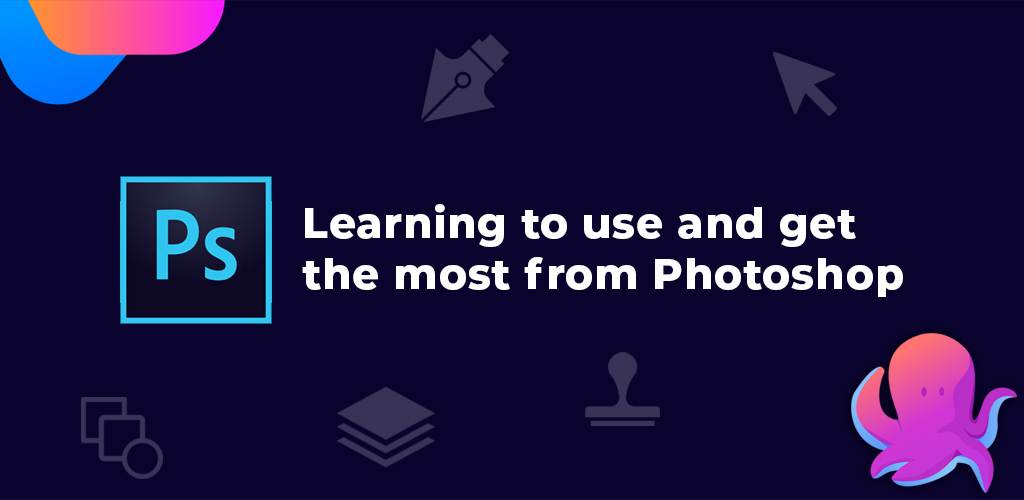

DropShip products from verified suppliers to diversify your inventory and scale your eCommerce business